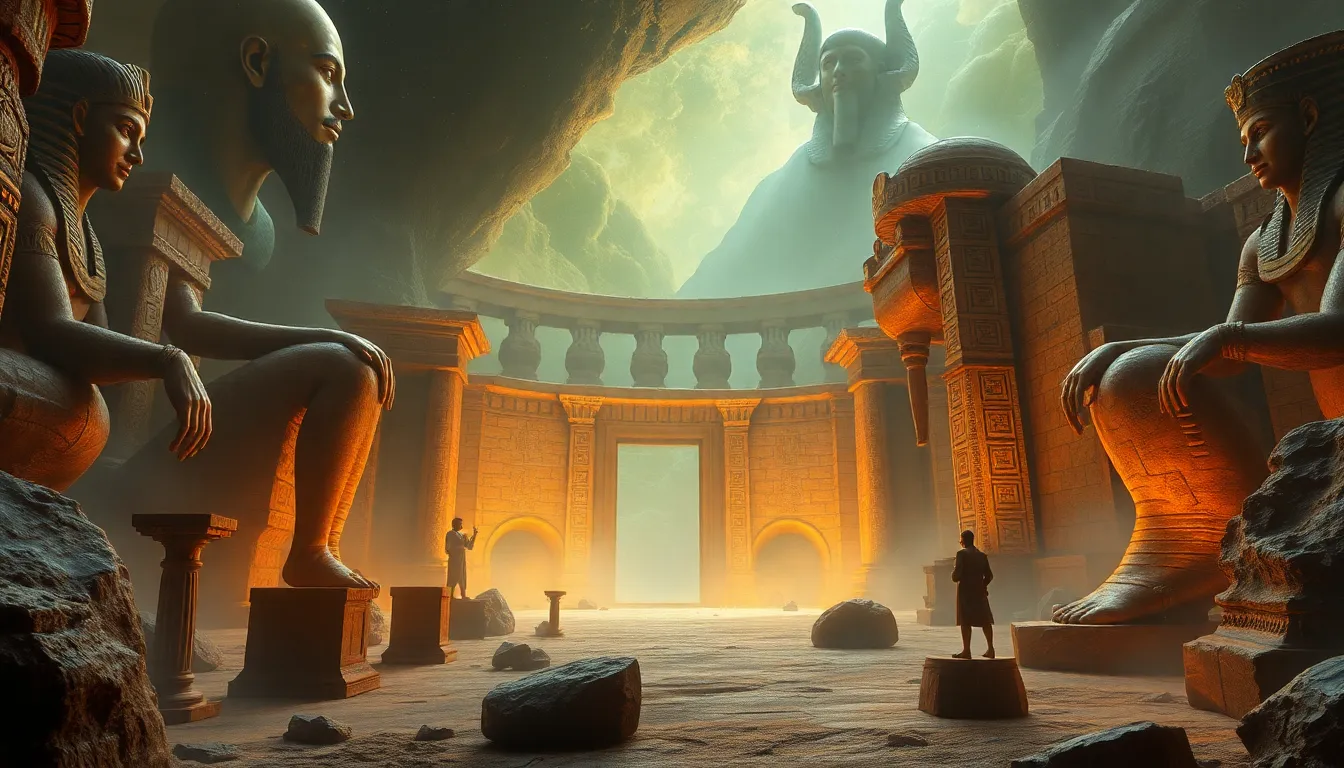The Underworld Unveiled: Myths of Duat and the Afterlife
I. Introduction to Duat
Duat, in Ancient Egyptian mythology, is the realm of the dead, a mystical place where souls journey after death. This afterlife domain is rich in symbolism and significance, reflecting the beliefs and values of a civilization that placed immense importance on the journey after life.
The cultural significance of Duat in Ancient Egyptian beliefs cannot be overstated. It represented both the final destination for the deceased and a complex landscape filled with challenges, deities, and moral judgments. This article will explore the myths surrounding Duat, its structure, the deities that inhabit it, the journey of the soul, and the rituals that accompanied the belief in the afterlife.
II. The Structure of Duat
Duat is often described as a vast and intricate geographical landscape, comprising various regions that each hold unique meanings related to the afterlife.
Key locations within Duat include:
- Hall of Ma’at: The place where the heart of the deceased is weighed against the feather of Ma’at, symbolizing truth and justice.
- Fields of Iaru: A paradisiacal realm where the blessed souls reside, often depicted as lush fields filled with food and drink.
The symbolism of different regions in Duat highlights the moral journey of the soul. The pathways through Duat are fraught with trials, reflecting the individual’s life choices and moral character.
III. Deities and Guardians of Duat
Numerous deities preside over Duat, each playing a vital role in the afterlife journey of souls. Some major deities associated with Duat include:
- Osiris: The god of the afterlife, resurrection, and fertility, Osiris judges the souls of the deceased.
- Anubis: The god of mummification and the protector of graves, Anubis guides souls through Duat.
- Ra: The sun god, who travels through the underworld each night, symbolizing rebirth and renewal.
These deities have specific roles and responsibilities that ensure the proper navigation and judgment of souls. Additionally, various guardians, often depicted as fearsome creatures, protect the gates of Duat, preventing unworthy souls from entering.
IV. The Journey Through Duat
The journey through Duat is a perilous expedition for the soul after death. It begins with the soul’s departure from the body and continues through a series of challenges and trials.
During this journey, the deceased faces:
- Monsters and obstacles that test their worthiness.
- Encounters with gods who assess their moral and ethical life choices.
One of the most critical moments in this journey is the “Weighing of the Heart” ceremony. In this ritual, the deceased’s heart is weighed against the feather of Ma’at. If the heart is lighter or equal to the feather, the soul is deemed worthy and can enter the Fields of Iaru; if it is heavier, the soul faces annihilation.
V. Myths and Legends of Duat
Several key myths are linked to Duat, each providing insight into the beliefs surrounding death and the afterlife. Notable myths include:
- The Resurrection of Osiris: This myth narrates how Osiris was killed by Set, dismembered, and later resurrected by Isis, symbolizing the cycle of life, death, and rebirth.
- The Journey of Ra: Each night, Ra travels through Duat, battling the serpent Apophis, representing chaos and darkness, which reinforces the concepts of good versus evil.
These myths serve not only as stories but also as moral lessons and metaphors for the eternal struggle between order and chaos. Their influence on Egyptian culture is profound, shaping their rituals, art, and societal values.
VI. Rituals and Practices for Navigating Duat
To ensure a successful journey through Duat, Ancient Egyptians engaged in various funerary practices. These rituals were designed to prepare the deceased for their afterlife journey.
Key practices included:
- Embalming and Mummification: Preserving the body to provide a vessel for the soul.
- Spells and Inscriptions: Texts such as the Pyramid Texts and the Book of the Dead contained spells that guided the deceased through Duat.
- Offerings and Burial Items: Items such as food, drink, and personal belongings were buried with the deceased to sustain them in the afterlife.
These practices highlight the belief in an enduring existence beyond death and the importance of honoring the deceased.
VII. Comparisons with Other Afterlife Beliefs
While Duat is unique to Ancient Egyptian beliefs, comparisons can be drawn with other cultural underworlds. For instance:
- Greek Underworld: Similar to Duat, the Greek underworld, ruled by Hades, also features a judgment process for souls.
- Mesopotamian Afterlife: The Mesopotamian view of the afterlife is less optimistic, often depicted as a dreary existence in the underworld.
The differences in the portrayal of the afterlife across cultures reflect varied beliefs about morality, justice, and the human experience. Despite these differences, the legacy of Duat continues to influence modern interpretations of the afterlife.
VIII. Conclusion
The significance of Duat in understanding Ancient Egyptian beliefs about death and the afterlife is profound. It serves as a reflection of their values, morality, and the human experience in the face of mortality.
The enduring fascination with myths of the afterlife reveals a universal human desire to comprehend what lies beyond death. These ancient concepts continue to resonate today, shaping contemporary views on life, death, and the mysteries of existence.




